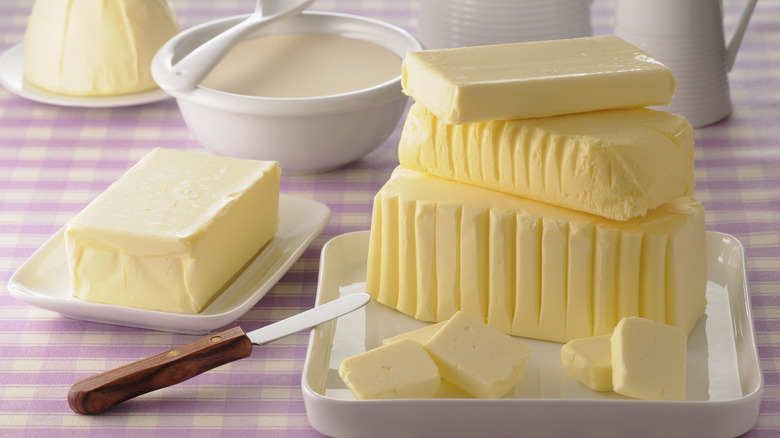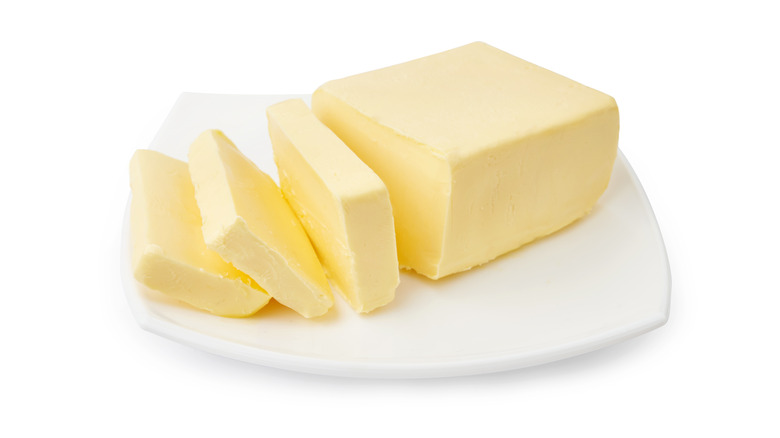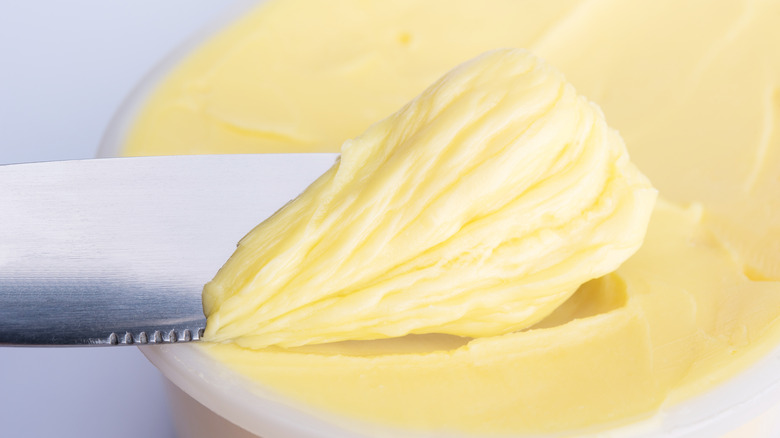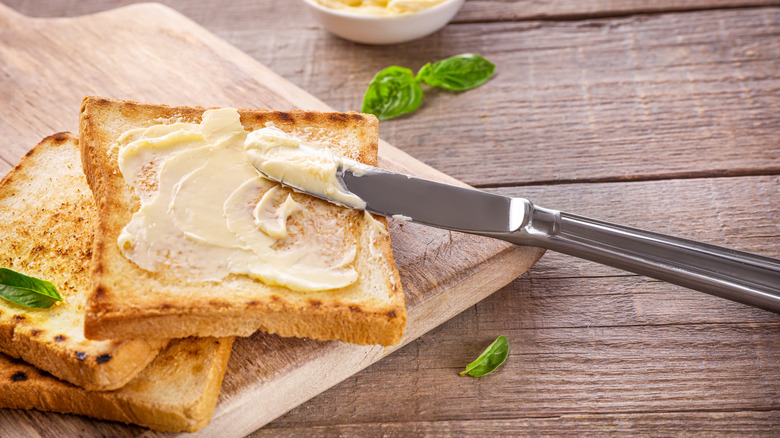Butter Vs. Margarine: How Is The Spread Different From The Real Thing?
Often used interchangeably, butter and margarine are spread on bread for grilled cheese, mixed with flour to create cookie dough, and melted in a pan to sauté vegetables. But just because they are often both used to create the same recipes, that doesn't mean butter and margarine are the same product or that it is even a good idea to substitute one for the other.
The biggest difference between butter and margarine, and why people often choose one over the other, is that butter is made from milk or cream, while margarine is comprised mostly of oil, water, and salt. The reputations of butter and margarine have also affected people's decision-making. In fact, margarine hasn't always been well-received in the United States, often because the dairy industry fought its presence, and as a result, margarine was subjected to restrictive legislation. Also called oleo, margarine's popularity has ebbed and flowed as health concerns changed. In the 1970s more people used margarine over butter because it was deemed healthier with fewer saturated fats, but in more recent years people have stayed away because of its reputation as an artificial food. But what's the difference, really?
Butter: a simply made dairy product
For thousands of years, making butter has been easily attainable to anyone who has access to cream. Simply churn cream rapidly, which forces the solids and liquids to separate. The butterfat solids can then be used plain or with salt. While making butter is relatively simple, the way it is used sometimes is not. Some of the common ways that butter is not used properly are not allowing it to reach room temperature for baking or permitting it to burn on the stove when melted. While browned butter may taste and smell good, burned butter does not. It also pays to be knowledgeable about butter when purchasing it. For sale as either salted or unsalted, both butters can be found on store shelves, though the two kinds will have subtle differences. Salted butter has a longer shelf life than unsalted butter because the salt serves as a preservative, but will take on a salty flavor, and may not taste as sweet or be as smooth as unsalted butter.
When it comes to how to use salted butter versus unsalted butter, the prior is better suited to spreading on corn on the cob or drizzling over popcorn, where the control of how much salt is used is not as important. However, for other recipes such as breads and cookies, it's best to use unsalted butter for total control.
Margarine: dairy-free and lower in fat
A lot of debate has taken place in homes since margarine was created in the late 1860s about whether to purchase it or butter. Modern margarine is dairy-free, but when margarine was first made in the United States after a patent was received in 1873, milk was still used with the melted fat to create the end product.
The fact that margarine looks very similar to butter is by design. Companies often add coloring to make margarine resemble butter, as well as add flavoring to make it taste similar. Unlike butter, making margarine is not easy and uses a chemical process. Although made in a factory, margarine is often bought over butter because it is lower in calories and saturated fat. That's because margarine is made from plant-based oils and fats, leading many to think it is the healthier option. But, margarine can contain trans fat, which raises LDL cholesterol (considered bad) and lowers HDL cholesterol (considered good). Trans fat also makes blood platelets more likely to stick together, increasing the risk of heart disease.
When it comes to cooking or baking with margarine, make sure it's comprised of at least 80% fat and is not a spread product that contains even less fat, or the finished item won't turn out as desired.
When to use butter vs. margarine
While many home cooks will substitute butter for margarine or vice-versa in a recipe, that isn't always advisable, although there are benefits to choosing one over the other for many recipes. For example, using margarine in baked goods, such as brownies, will help them to be softer — thanks to margarine's higher water content. Often, it's still best to follow the original recipe when it comes to margarine versus butter because older recipes that call for margarine will have considered its higher water content. Also, remember that reduced fat margarine will have an even higher water content.
That extra water content makes it best to stay away from margarine for cookies or frosting, which also rely on the sweet and creamy taste of butter. However, swapping margarine for butter can be done, but it's best to select a high-fat margarine that marketed for baking. Neither butter nor margarine are especially well-suited for frying because butter has an elevated risk of burning due to its milk solids, while margarine is more likely to burn because of its stabilizers. If a recipe calls for melted better, melting margarine instead may not work as well, because low-fat margarine might not melt at all or melt well.
If this all feels a bit complicated, there is a clear-cut way both margarine and butter can be used interchangeably: spreading on toast, bagels, or waffles.



